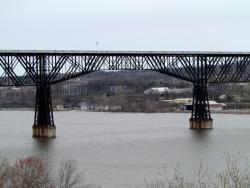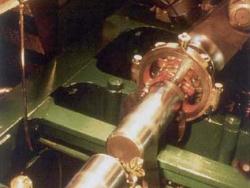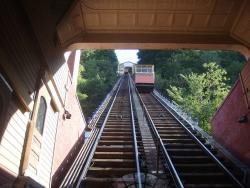A bridge across the Hudson at or near Poughkeepsie was planned starting in the early 1870s to primarily carry coal from the coalfields of northeastern Pennsylvania to New England. At the time there were no bridges between Albany and New York Harbor. Horatio Allen, soon to be President of the ASCE, was its first Chief Engineer. He designed a multiple span suspension bridge. Later the American Bridge Company started construction on a five span bridge but went bankrupt before it completed the first pier foundations.
Coal


The Northern Pacific High Line Bridge No. 64, built between 1907 and 1908, has continued to perform yeoman service in the uninterrupted flow of the Nation's commerce. Nearly, 100 years after this bridge officially opened, it still carries 125-ton car unit coal trains, double stack container trains, lumber, and refined products at train speeds of 50 m.p.h.

As a practical conveyance during the horse-and-buggy era, the Monongahela Incline was one of seventeen built and operated in Pittsburgh in the last century. Of the seventeen, the Monongahela and the Duquesne are the only two remaining operating units. While the Mt. Washington Incline was known as a coal-carrying incline plane in 1854, the Monongahela Incline is probably the earliest passenger-carrying incline in the United States and has been in continuous successful service since its construction.

The workforce consisted of less than 100 men, yet they finished construction in just 94 days. Such speed was possible due to the elimination of scaffolding. Instead, iron rods were used to support construction of the trusses between the towers, and workers moved back and forth across the rods. A dangerous venture, yet no workers were seriously injured.

The oscillating steam engine, built by John Penn & Sons, is located aboard the famed paddle steamer Diesbar. Diesbar is the second oldest of a fleet of nine paddle steamers in Dresden. What makes the Diesbar unique is its coal fueled engine and single deck design. The John Penn and Sons engine that runs the steamer is the oldest operational marine steam engine in the world. It has been in operation for over 165 years.
Innovations

The oscillating steam engine, built by John Penn & Sons, is located aboard the famed paddle steamer Diesbar. Diesbar is the second oldest of a fleet of nine paddle steamers in Dresden. What makes the Diesbar unique is its coal fueled engine and single deck design. The John Penn and Sons…
Read More
The workforce consisted of less than 100 men, yet they finished construction in just 94 days. Such speed was possible due to the elimination of scaffolding. Instead, iron rods were used to support construction of the trusses between the towers, and workers moved back and forth across the rods. A…
Read More
As a practical conveyance during the horse-and-buggy era, the Monongahela Incline was one of seventeen built and operated in Pittsburgh in the last century. Of the seventeen, the Monongahela and the Duquesne are the only two remaining operating units. While the Mt. Washington Incline was known…
Read More
The Northern Pacific High Line Bridge No. 64, built between 1907 and 1908, has continued to perform yeoman service in the uninterrupted flow of the Nation's commerce. Nearly, 100 years after this bridge officially opened, it still carries 125-ton car unit coal trains, double stack container…
Read More
A bridge across the Hudson at or near Poughkeepsie was planned starting in the early 1870s to primarily carry coal from the coalfields of northeastern Pennsylvania to New England. At the time there were no bridges between Albany and New York Harbor. Horatio Allen, soon to be President of the…
Read More

